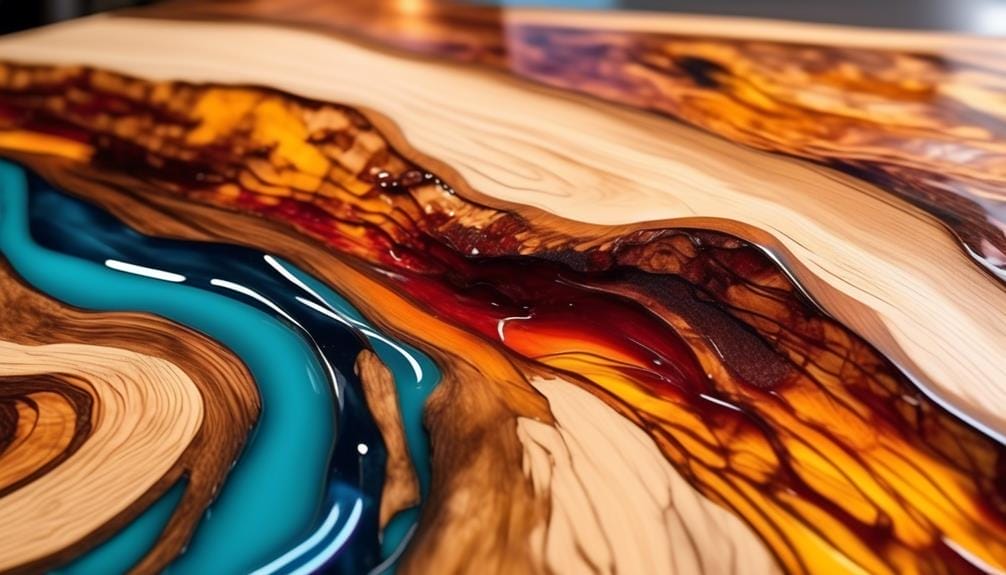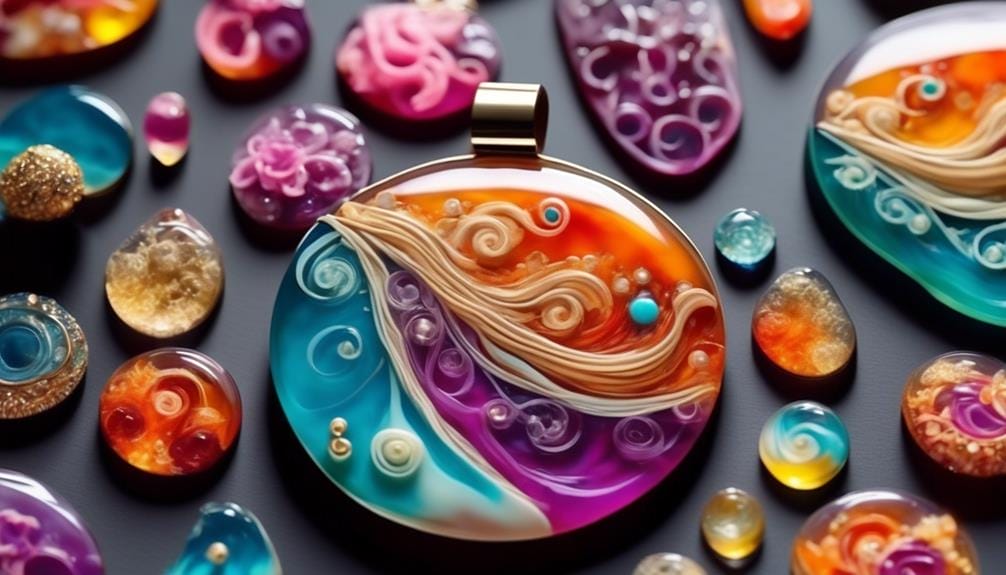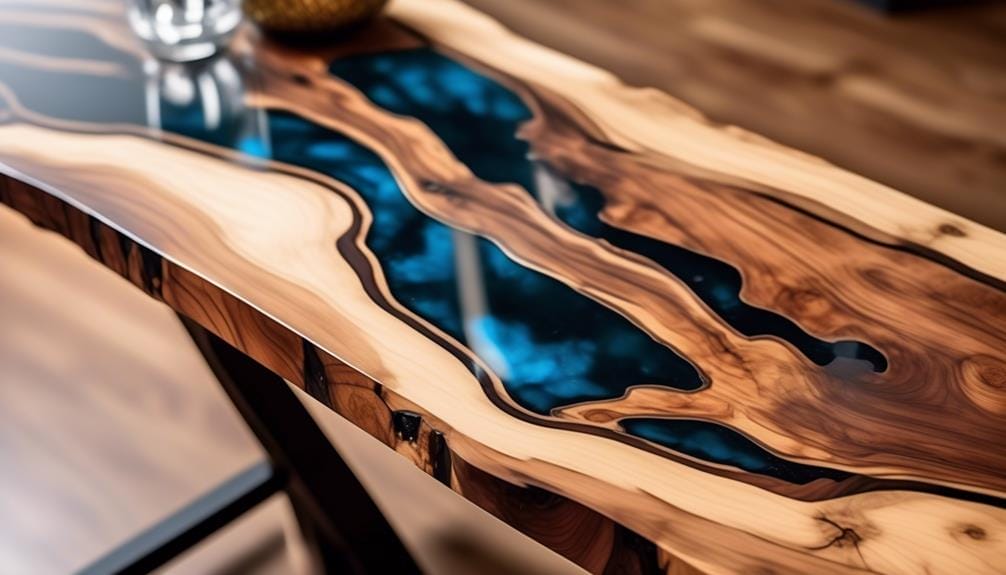You've probably heard of epoxy resin and its many applications in the world of crafts and DIY projects.
But did you know that there is a whole realm of advanced epoxy techniques waiting to be explored? These techniques go beyond the basics, allowing you to create intricate designs, unique combinations, and stunning finishes.
From geode-inspired designs to resin jewelry making, the possibilities are endless.
So, if you're ready to take your epoxy skills to the next level and unlock a world of creativity, keep reading to discover the fascinating world of advanced epoxy techniques.
Key Takeaways
- Layering vibrant colors of epoxy resin can mimic the natural beauty of geodes and create visually stunning designs.
- Incorporating crystals into epoxy resin projects adds sparkle and texture, enhancing the overall aesthetic.
- Experimenting with different techniques and blending colors allows for the creation of unique and abstract effects.
- Using silicone molds enables the creation of intricate shapes, adding depth and dimension to resin projects.
Geode-Inspired Designs
Geode-inspired designs in epoxy involve layering vibrant colors, incorporating crystals, and utilizing various additives to create stunning resin formations with intricate shapes and unique effects. These designs are created by carefully selecting and layering different colors of epoxy resin to mimic the vibrant hues found in natural geodes.
To add a touch of sparkle and texture, crystals are embedded into the resin, creating a mesmerizing effect when the light catches them.
In addition to color and crystals, geode-inspired designs can incorporate abstract effects using alcohol inks and other pigments. These inks are carefully applied to the resin, creating beautiful patterns and textures that resemble the organic formations found in geodes. By experimenting with different techniques and blending colors, artists can achieve a wide range of effects, from subtle and natural to bold and abstract.
To create intricate shapes, silicone molds are often used in geode-inspired designs. These molds allow artists to cast the epoxy resin into specific shapes, such as crescents, ovals, or irregular geometric forms, adding a unique touch to the final piece. The versatility of silicone molds enables artists to push the boundaries of their designs, creating truly one-of-a-kind geode-inspired creations.
Epoxy Pigment Effects
To achieve vibrant and unique colors in resin projects, epoxy pigment effects can be utilized. By mixing different pigments, you have the ability to create custom colors and achieve the perfect shade for your project. This advanced technique allows for endless possibilities and the ability to blend colors seamlessly.
Layering pigments can take your resin pieces to the next level, adding stunning depth and dimension. Imagine a piece that looks like a shimmering pool of water or a mesmerizing galaxy captured in resin. Experimenting with metallic and pearl pigments can create a beautiful shimmer and luster in the epoxy, giving your project an elegant and eye-catching finish.
On the other hand, using translucent pigments can create ethereal effects, allowing light to pass through the resin and giving it a delicate and enchanting appearance.
With epoxy pigment effects, you can truly elevate your resin projects and create something truly extraordinary.
Resin and Wood Combinations

You are about to explore the fascinating world of resin and wood combinations. By combining epoxy resin with wood, you can achieve unique and natural-looking finishes that enhance the wood's natural beauty.
The application of resin not only fills voids, cracks, and knots in the wood, but also creates durable and long-lasting surfaces.
Let's delve into the techniques that allow you to create intricate patterns and designs using resin and wood.
Unique Material Combinations
What are the benefits of combining resin and wood in epoxy techniques?
The combination of resin and wood in advanced epoxy techniques offers a multitude of benefits. Here are five reasons why you should consider this unique material combination:
- Visually Striking and Durable Finish: The combination of resin and wood creates a visually striking finish that's also highly durable, ensuring that your project will withstand the test of time.
- Varied Effects: Experiment with different wood types and resin colors to achieve a wide range of effects, from subtle and natural to bold and vibrant.
- Seamless and Polished Surface: The resin and wood combination creates a seamless and polished surface that showcases the natural beauty of the wood.
- Organic Warmth meets Modern Look: Explore the contrast between the organic warmth of wood and the sleek, modern look of resin, creating a captivating visual interplay.
- Enhanced Grain and Texture: Utilize resin to enhance the natural grain and texture of wood, adding captivating visual depth to your project.
When it comes to advanced epoxy techniques, combining resin and wood opens up a world of possibilities, allowing you to create unique and stunning pieces that stand out from the crowd.
Enhancing Wood Grain
Combining resin and wood in advanced epoxy techniques not only creates visually striking and durable finishes, but it also offers an opportunity to enhance the natural grain of wood surfaces. By experimenting with different wood types, you can achieve unique visual effects when combined with resin.
The resin serves to protect and showcase the natural beauty of wood grain. To enhance the depth and richness of wood grain, translucent and pigmented resin can be used. This combination of woodworking and resin techniques allows you to create stunning and durable finishes that highlight and enhance the intricate patterns and textures of the wood.
With these advanced epoxy techniques, you can achieve a visually captivating and long-lasting enhancement of the wood grain.
Resin Application Techniques
To achieve successful resin and wood combinations, it's crucial to properly mix the resin and apply it in thin layers for even coverage and to prevent air bubbles. Here are some resin application techniques you should keep in mind:
- Follow the recommended mixing ratio to ensure the resin cures properly and adheres well to the wood surface.
- Apply the resin in thin layers, using a brush or roller, to avoid drips and achieve an even coating.
- Prior to resin application, sand the wood surface to remove any imperfections and create a smooth base for the resin to adhere to.
- Use a torch or heat gun to carefully remove any trapped air bubbles in the resin, ensuring a smooth and flawless finish.
- Always work in a well-ventilated area and wear appropriate safety gear, such as gloves and a respirator, to protect yourself during the resin application process.
Resin Jewelry Making

Resin jewelry making offers a versatile and creative method to craft unique and personalized jewelry pieces by embedding various materials in resin. This technique allows for experimentation with different colors, shapes, and textures, resulting in one-of-a-kind accessories. Resin jewelry can be made using techniques like resin casting and mold usage, which enable the creation of intricate and detailed designs. However, it is important to prioritize safety when working with resin. Proper ventilation and the use of protective gear are crucial to ensure a safe and enjoyable jewelry-making experience.
To give you a better understanding of resin jewelry making, here is a table outlining some key aspects of this technique:
| Aspects of Resin Jewelry Making | Description |
|---|---|
| Materials | Flowers, beads, trinkets, etc. |
| Techniques | Resin casting, mold usage |
| Customization | Colors, shapes, textures |
| Safety Precautions | Proper ventilation, protective gear |
Creating Resin Art
When creating resin art, it's essential to understand the proper techniques and materials required for achieving stunning and long-lasting results. To help you on your resin art journey, here are some key points to keep in mind:
- Choose the right epoxy resin: Look for a high-quality epoxy resin that's specifically formulated for art purposes. This will ensure optimal clarity, UV resistance, and durability for your artwork.
- Prepare your workspace: Before you start pouring resin, make sure your workspace is clean, well-ventilated, and free from dust and debris. This will help prevent any unwanted particles from getting trapped in your resin.
- Mix resin and hardener properly: Follow the manufacturer's instructions carefully when mixing resin and hardener. Use a graduated measuring cup and stir slowly to avoid introducing air bubbles into the mixture.
- Add color and effects: Get creative with color pigments, dyes, and additives to add depth and visual interest to your resin art. Experiment with different techniques like layering, swirling, or creating cells to achieve unique effects.
- Use proper safety precautions: Epoxy resin can be toxic if not handled correctly. Always wear gloves, a respirator, and protective eyewear when working with resin. Make sure to work in a well-ventilated area or use a respirator to avoid inhaling any fumes.
Resin in Woodworking

Using epoxy resin in woodworking provides a cost-effective and durable solution for various remodeling projects, countertop renovations, and budget-friendly options for homeowners. Epoxy resin offers an easy-to-use application process with user-friendly instructions, making it accessible to individuals without professional skills. Its heat-resistant properties make it suitable for kitchen use, providing a safe surface for hot pots and pans. Additionally, epoxy resin has zero VOC content, making it an environmentally friendly and safe option for indoor use. This is especially beneficial for individuals with sensitivities or allergies.
One of the key advantages of using epoxy resin in woodworking is its super durability and resistance to impacts and daily wear and tear. This makes it an ideal choice for high-traffic areas or furniture that experiences heavy use. Moreover, epoxy resin can be easily renewed after years of use, ensuring that your woodworking projects remain in top condition for a long time.
To provide a visual representation of the benefits of epoxy resin in woodworking, the following table highlights its key features:
| Feature | Description |
|---|---|
| Cost-effective solution | Affordable option for various woodworking projects. |
| Easy application process | User-friendly instructions for non-professionals. |
| Heat-resistant properties | Safe surface for hot pots and pans in the kitchen. |
Frequently Asked Questions
What Is the Hardest Type of Epoxy?
The hardest type of epoxy is typically determined by its strength and durability. Epoxy strengths can vary depending on the specific formula and application, but high-performance epoxies with reinforced fibers are often considered the toughest.
What Does Epoxy Not Stick To?
Epoxy does not stick to certain plastics like polyethylene or polypropylene, smooth and non-porous surfaces such as glass or metals, silicone, Teflon, or surfaces with oil, grease, contaminants, or high moisture content.
How Do I Get a Smooth Finish With Epoxy?
To get a smooth finish with epoxy, you should start by mastering the pouring technique. Make sure to mix the resin and hardener properly, eliminate air bubbles with a heat gun, and follow safety precautions for a flawless result.
What Is the Best Way to Apply Epoxy?
To apply epoxy, start by preparing the surface, ensuring it's clean and level. Mix the resin and hardener in the correct ratio, then pour it onto the surface using pouring techniques to achieve an even and smooth finish.
Conclusion
In conclusion, mastering advanced epoxy techniques opens up a world of possibilities for creating stunning and personalized resin projects. Whether it's geode-inspired designs, playing with epoxy pigment effects, combining resin with wood, making resin jewelry, or exploring resin art, the intricate methods and unique finishes achieved through these techniques can result in truly breathtaking creations.
So grab your epoxy resin and let your imagination run wild as you delve into the world of advanced epoxy techniques.





